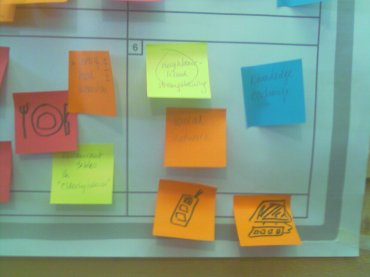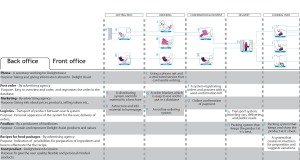We had a very interesting conference on service design a couple of weeks ago, in Amsterdam. It was not the first, but it was clear that we are still at the very early stage of the definition of service design as a discipline (from the academic perspective) and as a fully defined professional competence, from the perspective of professional design studios. I started writing this post with the intention of reflecting on what’s next, but I should probably reflect on what’s going on right now.
The evidence that we are still at the earliest phase is that everyone is trying to find a definition of service design. The research of a definition is, in my opinion, disorienting and sometimes misleading. Of course it is perfectly legitimate, and in fact I keep reading messages in mailing lists about much more “mature” disciplines (e.g. industrial design) asking questions about definition of the discipline (in some industrial design lists this question comes out every second month and triggers never-ending discussions). However the definition of the competence and area of influence of industrial design is quite well defined and solid and such questions are not changing it too much, whereas the lack of a background in service design makes the discussion about the definition a time-demanding (and consuming) activity that many practitioners and academic, me included, would like to avoid, so that more time is available to work on cases, methods and tools.
I don’t want to dismiss the discussions whether service design relates to interaction design, or experience design or industrial design, this is a very interesting discussion and in fact I think that it would be stupid to ignore the inputs and the methods those disciplines can provide to service design. However I believe the most important think to do in this moment is to “learning by doing”, thus collecting methods, tools, experiences from whatever discipline, including social studies, anthropology, economics, engineering, etc, and generate a toolbox for service design to operate on concrete cases. In other words I feel the need for an “operative paradigm” on service design. The term operative paradigm is taken from Arbnor and Bjerke (Arbnor and Bjerke 1997); I explain this term with the metaphor of the plumber’s toolbox: the plumber uses the various tools in his toolbox according to his own needs: sometimes he needs a spanner and sometimes a screwdriver. Both spanner and screwdriver are also used by electrician and other professions, but the plumber doesn’t care about who else uses those tools, he just uses them, adapting the tools to the problem he has to solve. An operative paradigm is a toolbox including methods and tools that others may have developed in other disciplines. As far as such tools can be adapted to solve a problem in service design, they are meaningful and should be used. Sometimes the way we use those tools is not exactly the same way other disciplines would use them. Ethnographers, for instance, use video observation for analyzing people, whereas service designers use it as a starting point to change the way people behave. As any other designer, service designers work with such tools as “bricoleurs”. Ethnographer would be horrified by the way we use video observations for instance. But we use them anyway, as far as they are effective and produce some result. I personally experienced several negative reviews to my funding applications to social studies research councils, when I presented my research proposals. The common answer was that what I was proposed was a project, not a scientific research! But I found that this “non-scientific” work, has given me some results and I’m trying to find a way to put them in my personal toolbox.
What’s next part 1
So, to answer the question “what’s next?” I would say that a very first task is to create this toolbox, possibly using cases (I expect professionals to contribute in this sense) and methods, provided by researchers and academic studies. We have seen some good tools for our toolbox in the conference in Amsterdam, but I think that much more tools should be added, to deal with other tasks in service design.
What’s next part 2
Another consideration about “what’s next” concerns the question of industrialization of services. What we have seen at the conference was a sort of “craftsmanship state” of service design: each case was a single one, very localized, very much related to the context and the actors participating to it. Localisation and personalization of services are in fact what makes service relevant in the age of mass customization. In fact I would argue that service would possibly bring us beyond mass customization, towards highly personalized solutions. However I also think there is a need to investigate some of the aspects coming from the tradition of industrial design. Industrial design started when someone translated the knowledge in the craftsman’s brain into drawings and codified signs (blueprints) that could transfer this knowledge to others, therefore making this knowledge reproducible. Talking about the industrialisation of service means considering how local and highly customised solutions could be translated from one context to another, from one individual to another. This is not an academic speculation, this is a practical question. Working on individual solutions would be very expensive for any business, if they could not find a way to re-use the same knowledge from something else. With industrial production companies where reusing this knowledge as embedded in products, with the result that the same product could be sold to many different people. In service design the knowledge should be embedded into service activities, procedures, journeys (the most used term in the conference). The result of the industrialisation of services is that the same knowledge, capabilities, skills, interactions, could be proposed in different contexts, although the final product would not be standardised.
The service blueprint is of course the main tool we can use for industrialising services, however the blueprint we have seen so far are just focusing on the individual experience. The mechanism that would make the underlying knowledge reproducible in other contexts or to other individual is still unclear. So this is what I hope to see more insights in the next future.
References
Arbnor, I. and B. Bjerke (1997). Methodology for creating businesss knowledge. Thousand Oaks, Calif. ; London, Sage.



